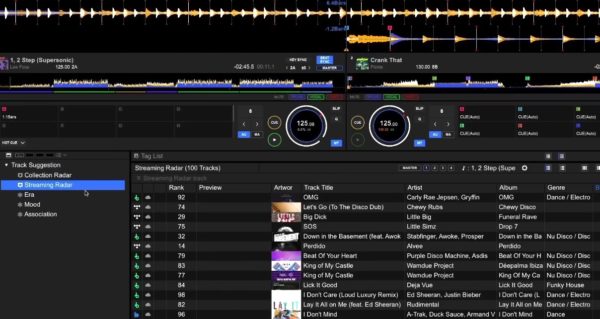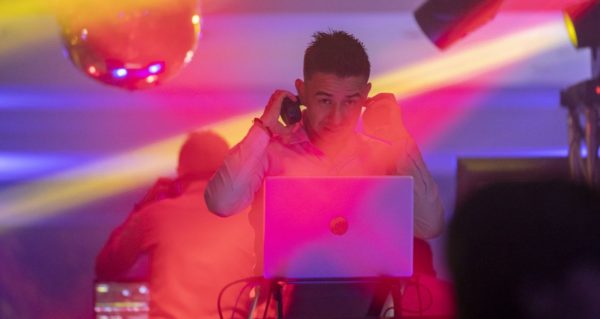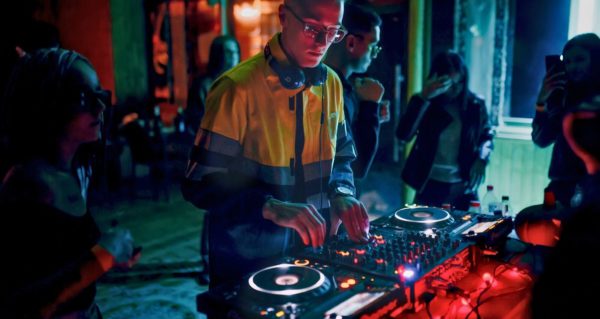Knowing what to play next, if you think about it, is at the actual heart of what DJs do. Runners put one bart in front of another. Cyclists push down on the left pedal, then the right pedal, and then do it again and again and again. And DJs, every few minutes, play a new song.
And, of course, what you play defines who you are as a DJ. It’s not for nothing that the phrase “a DJ is only as good as their last song” stuck. So how do you know what to play next?
A note on music algorithms
There are whole services and whole advances in DJing dedicated just to helping you do this. At the time of writing this article, Rekordbox 7 DJ software has just been released, which has a whole host of AI features to help you choose the next song, as just one example within DJ software.

Streaming services like Spotify, Apple Music, and so on, spend an awful lot of money on algorithms designed to “tune” the music they play to you as an individual so that you’ll keep the service open and keep the play button pressed. In other words, they are doing exactly what I’m talking about here in a way that’s tailored to you as a subscriber.
With this being such a fundamental question, you’d think the answer would come naturally, right? But here’s the thing: It scares the hell out of DJs, especially new DJs.
Learn to DJ with us: The Complete DJ Course
And it’s curious, because most people get into DJing because they have a strong sense that they know what people are going to want to hear, and that they have a bigger knowledge of music than the average person.
Why programming matters
I’m sure you’ve been to a party where the person who’s commandeered the music keeps leaving huge gaps because they play one song on YouTube and can’t think of what to play next. Maybe the phrase, “last night a DJ saved my life,” really came from the fact that if there’s a DJ in the house, at least there will be no gaps!
However, we can all be paralysed when the stress is high, and forget how to do this basic thing. And so in this article and it’s accompanying video, I talk you through seven ideas for choosing the perfect next track.
This is based upon the seven ideas that we cover in our Amazon global bestselling book on how to DJ, Rock the Dancefloor! In it, I take you right back to basics, and hopefully give you the confidence you need to be able to do this stress-free.
7 Ways To Know What To Play Next
1. Play the song instinct is telling you is right

Look, you’re the DJ for a reason. You’ve practised a lot, you’ve spent a lot of time assembling your music, and you already have a sense of what people want to hear because you know what you want to hear.
So don’t overthink this. Your instinct is probably right. Just play the song that instinct is telling you.
2. Pick something at a similar tempo, in the same genre, or in a compatible musical key
All of these things are very likely to smoothly take your audience from what you’re currently playing to the next track. Think of them like a well-oiled slide, offering no resistance as you move from one track to the next.
The same tempo means people can continue to dance in the same way. The same genre means a lot of people won’t even notice the song has changed. And a compatible musical key will help smooth over anything else that is different between the tracks, making it sound like it was meant to be (musically, at least).
Read this next: The Ultimate Guide To Keymixing For DJs
You can sort by all of these columns in your playlist, in your DJ software, or on your DJ system to quickly see tracks that match these criteria next to each other, effectively giving you a short list of tracks that you can choose from.
3. Play something in a totally different BPM, genre, or key

DJ sets that carry on from beginning to middle to end without any changes are boring. And while you won’t do this one as often as the first two, mindfully changing things up can be just the ticket for a flagging dancefloor.
One thing I learned very early on in my DJing career is that when people are tired, dropping the BPM but increasing the familiarity of the music you’re playing can be just the ticket to fill the dancefloor again. This is one example of changing up the BPM and/or genre to improve things.
Likewise, if you’ve been using modern DJ techniques to mix in key for a little while, deliberately changing the musical key can prick people’s ears up – like switching to a different camera angle in a movie. Don’t be scared to do these things.
4. Play something that’s worked before
Again, don’t overthink. Not sure what to play next? What did you play last time? Do that.
This is a big no-no for some DJs. But honestly. no one’s listening to your DJing anywhere near as closely as you think they are. And while, no, it’s probably not a good idea to play all the same songs in the same order all the time, but if a tune worked well last week at a venue you’re playing in and you’re not sure what to play next, play that tune again.
There’s a reason that you hear the same songs over and over again on the radio with only small changes day after day and week after week. And that’s because people like familiarity. You don’t have to play a completely different DJ set every time you play somewhere. So don’t attempt to – You’re making too much work for yourself, and it’s not expected.
The history section of your DJ software can be a good place to look because you can look back at what you played last week or last month or even last New Year’s Eve and find what worked then. Do that.
5. Play something you’ve never played before

We all have tunes that we’ve got a strong conviction are going to work on our dancefloors, but that we don’t dare play. They hang around at the back of our virtual record crates daring us to play them.
If everything’s going well, instinct isn’t suggesting something in a similar BPM or genre or key that is inspiring you, and you get a sense the dancefloor wants something new rather than something that they know, then take a chance. Sometimes tunes that you worry about end up being your favourites.
Rock ANY gig like a pro: The Complete DJ Course
All I’d recommend is having a plan B in case the worst happens, and something you’re taking a risk on does clear the dancefloor. If you know what you’re going to do next in that circumstance, then it’s a simple job of letting that song play for a minute and then mixing it out and putting something else on.
6. Play something that lyrically matches the moment
This is where real life human DJs win over AI, jukeboxes, and playlists every time.
Cheekily playing KRS-One’s “Sound of the Police” as the police pay the venue a visit. Dropping Blue Pearl’s “Naked in the Rain” as it starts to rain at a festival. These are two that have worked for me in the past and there’s nothing clever about this other than spotting the moment and jumping on it.

After all, Queen’s “We Are The Champions” and Stevie Wonder’s “Happy Birthday” are both evergreens and in many DJs’ boxes decade after decade for a reason.
7. Play a big hit/floorfiller
All DJs have these songs. Keep a playlist of guaranteed floor fillers. They’re going to be different wherever you are in the world, but you know the big songs from the last couple decades that have always filled dancefloors where you live.
Treat this as your ultimate fallback folder. It’s your safety net. It’s the thing that you’ve got that means if any of the other six ideas I’ve just given you fail, you’re not going to hit the ground because you’re going to go into that folder, you’re going to pick one of these songs and you’re going to rescue things.
Finally…
Choosing tracks that will make the perfect DJ set for the people in front of you right now needn’t be difficult, as you’ve just seen. But that said, if DJing is both an art and a craft, then the craft bit is the mixing, but the art bit is definitely the programming, the choosing of tunes. It’s a lifetime’s work, and it’s never done because music and tastes keep changing.
Dive deeper and get your FREE “Perfect Next Song” checklist & worksheet

The best you can do is to learn and apply certain rules (like the ones I’ve shared with you here), so that nothing is done at random and you’re at least thinking a little bit about every next track you play.
And while no DJ set is going to go without its ups and downs, hopefully some of the tips I’ve given you will help you to play better DJ sets more frequently, and to get it right more often.



